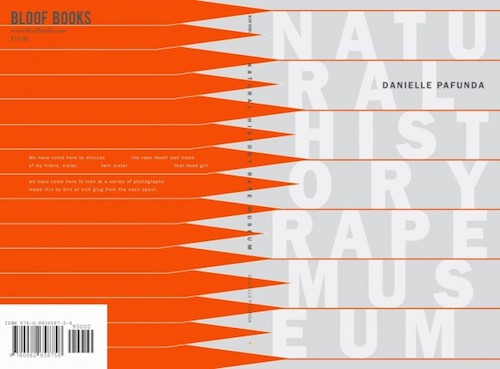Danielle Pafunda's Natural History Rape Museum

At Coldfront, a natural pairing: Timothy Liu reviews Danielle Pafunda's Natural History Rape Museum (Bloof Books 2013). Liu writes: "[N]o other book I know has so thoroughly shaken the fuckwad out of my pudenda." More:
Disclosures: I heard her perform many of these poems at the Lynchian Jewel Box Theater in Seattle (sans cellist!) and was shocked to feel my latent masochistic inner-heterosexual demand that she never stop doing what she does best, all “safe words” be damned.
Favorites: “You put me in the dress, I’m just wearing it. Externally.”; “Stingray”; “Punishment”; and her epic serial “On the Bearskin Rug in Front of the Fire I Construct the Following Tableau:”
It's a quick one! We want more. So we sought out. Pafunda also got some writeup from Paula Mendoza at Michigan Quarterly in January. Her review contends more with categorical distinction. An excerpt:
Years enough have taught me that misogyny doesn’t distinguish between the two, and I’ve come around to recovering the complexities and useful darknesseses found within that idea of ‘girl’.
Among several poets I consider to be writing towards this recovery is Danielle Pafunda, whose newest book, Natural History Rape Museum, was released just last month by Bloof Books. In an essay for the feminist issue of the literary journal, Volta, Pafunda writes:
Girl is a category that the patriarchy has deigned to construct in only the broadest strokes. In refusing to become woman, in continuing to become or occupy the category girl there may be some radically subversive potential. […]
The girl is uncultured and unrefined, crude and raw (though like much raw food, teeming with live active cultures, possessed and pungent). Let us be very clear. The girl I once was burdens me. I spend a great deal of time bleaching her out. She makes us vulnerable and ruins every day of our life. Though her shame frequency cannot be overwritten, it can be mined, directed, and amplified.
Upon re-readings of NHRM, it was to this lens I returned, integrating my impressions and feelings into the larger, ongoing dialogue of feminist poetics, to the idea of voice, and the frequencies we emit and receive.
One such frequency may be ‘Gurlesque’, a word that stitches together Riot Grrl, grotesque, and burlesque, and names a loose confederacy of aesthetic sympathies and ideas, as well as an anthology of several contemporary poets.
I admire much of work associated with the Gurlesque, and, for all the reductive tendencies of literary movements and other types of branding, it helped cast a critical light on a lot of excellent ill-mannered, and riotous poetry. I’m a fan of Pafunda’s work in particular (included in this anthology), and appreciate the cruelty of her playfulness, her girlish macabre veering into full-on demented—qualities that are realized by the high artifice of her poems.
[...]
I remember first hearing about this most recent collection, and thinking that there are a handful of words in the English language I’m averse to. The word ‘rape’, no matter how mundane or clinical the context of its appearance, elicits a visceral and instantenous reaction. There are some words, when said over and over, that grow strange in one’s mouth, and over several permutations cognitively disintegrate into their discrete phonemes, their noises. Rape is not one of those words; it has the brute integrity of fact, insoluble and fixed. Upon reading these poems, I imagined that word—its hardness, a high stone wall— and thought that this is what language might sound and look like when hurled against it.


